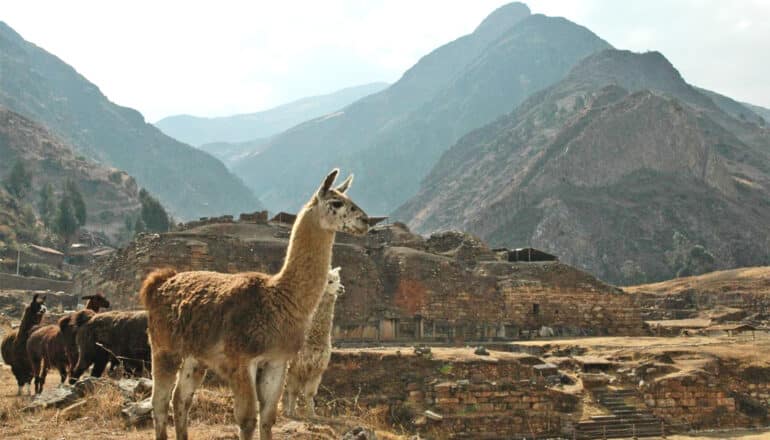Leaders used psychedelics to enforce class in the ancient Andes
- Researchers have discovered evidence of ancient psychedelics used by the Chavín Phenomenon society in modern-day Peru, which helped create class hierarchies in the Andes.
- The use of psychoactive plants like nicotine and vilca bean residue was found in snuff tubes carved from hollow bones at monumental stone structures, suggesting a tightly controlled ritual for select individuals.
- These rituals were exclusive and likely reserved for a small group of participants, reinforcing social hierarchy and ideology, according to anthropological archaeologist Daniel Contreras.
- The use of psychedelics was not just about personal visions but also about creating an air of mystique and control, which helped justify inequality and naturalize the social order.
- The study’s findings provide new insights into the Chavín Phenomenon society and its role in shaping early class structures, using a combination of archaeological excavations and advanced analytical methods.

New research digs into how ancient psychedelics helped create class hierarchies in the Andes.
Two thousand years before the Inca empire dominated the Andes, a lesser-known society known as the Chavín Phenomenon shared common art, architecture, and materials throughout modern-day Peru.
Through agricultural innovations, craft production, and trade, Chavín shaped a growing social order and laid the foundations for hierarchical society among the high peaks.
But one of their most powerful tools wasn’t farming. It was access to altered states of consciousness.
That’s according to a new study that uncovered the earliest-known direct evidence of the use of psychoactive plants in the Peruvian Andes.
A team of archaeologists from the University of Florida, Stanford University, and South American institutions discovered ancient snuff tubes carved from hollow bones at the heart of monumental stone structures at Chavín de Huántar, a prehistoric ceremonial site in the mountains Peru.
By conducting chemical and microscopic analyses of the snuff tubes, the researchers revealed traces of nicotine from wild relatives of tobacco and vilca bean residue, a hallucinogen related to DMT. The leaders, it seems, wielded these substances not just for personal visions but to reinforce their authority.
Unlike communal hallucinogenic use common in other ancient cultures, Chavín’s rituals were exclusive. Archaeologists discovered the snuff tubes in private chambers within massive stone structures that held only a handful of participants at a time, creating an air of mystique and control.
“Taking psychoactives was not just about seeing visions. It was part of a tightly controlled ritual, likely reserved for a select few, reinforcing the social hierarchy,” says Daniel Contreras, an anthropological archaeologist at the University of Florida and coauthor of the new study that revealed these rituals at Chavín.
These experiences were likely profound, even terrifying. To those who inhaled, the supernatural might have felt like a force beyond comprehension. And that was precisely the point. By controlling access to these altered states, Chavín’s rulers established a potent ideology and convinced their people that their leadership was intertwined with mystical power and part of the natural order.
The snuff tubes were discovered in this private chamber, revealing how the associated rituals were restricted and special.
“The supernatural world isn’t necessarily friendly, but it’s powerful,” Contreras says. “These rituals, often enhanced by psychoactives, were compelling, transformative experiences that reinforced belief systems and social structures.”
Contreras has spent nearly thirty years studying the site as part of a team led by John Rick, professor emeritus at Stanford University. The team argue that these ceremonies were pivotal in shaping early class structures. Unlike forced labor societies, Chavín’s builders likely believed in the grandeur of the monuments they were constructing, persuaded by these immersive rituals.
Those rituals extended beyond the use of psychedelics. Archaeologists have also uncovered trumpets made from conch shells and chambers seemingly designed to enhance the awe-inducing musical performances.
“One of the ways that inequality was justified or naturalized was through ideology—through the creation of impressive ceremonial experiences that made people believe this whole project was a good idea,” Contreras says.
Their study appears in the Proceedings of the National Academy of Sciences.
The findings help solve a century-old mystery about this site, located at an elevation of 10,000 feet. Since its first excavation over a hundred years ago, Chavín has been seen as related to both earlier, more egalitarian societies and the mountain-spanning empires ruled by powerful elites that came later.
Controlled access to mystical experiences helps explain this major social transition, a finding only made possible by decades of intense excavations and advanced analytical methods.
“It’s exciting that ongoing excavations can be combined with cutting-edge archaeological science techniques to get us closer to understanding what it was like to live at this site,” Contreras says.
Source: University of Florida
The post Leaders used psychedelics to enforce class in the ancient Andes appeared first on Futurity.
